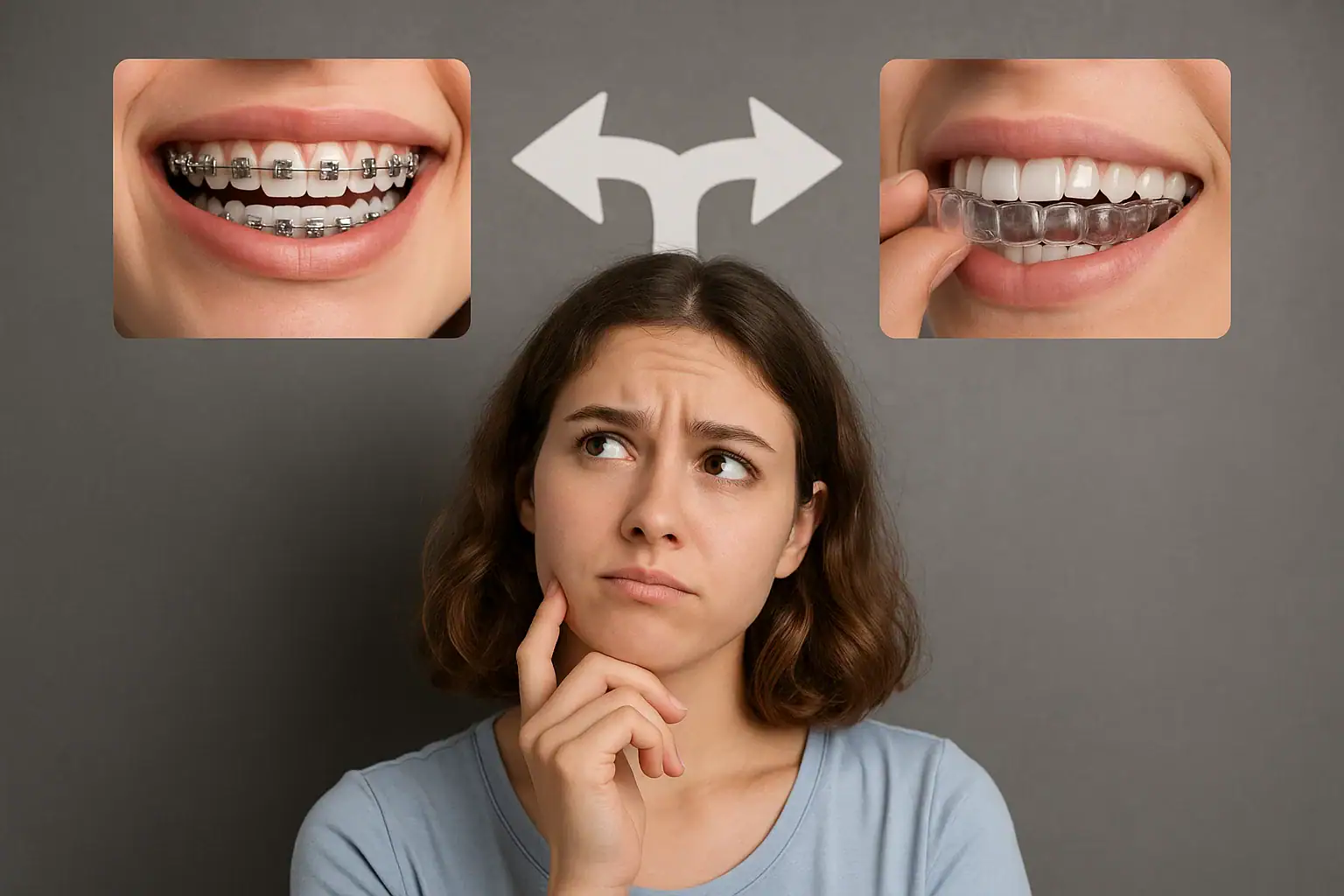Menu
Free Consultation

When it comes to straightening teeth and achieving the perfect smile, patients today are presented with two primary options: braces and aligners. Each has its strengths and limitations, and the best choice often depends on a variety of personal, medical, and lifestyle factors. In this comprehensive guide, we’ll explore the key differences between braces and clear aligners, their costs, benefits, treatment durations, and more.
Braces are traditional orthodontic devices consisting of metal brackets and wires that gradually shift teeth into proper alignment. Braces may also include rubber bands or other components, depending on the complexity of the case.
Common Features of Braces:
Clear aligners, such as Invisalign, are removable trays custom-made from clear plastic. They fit snugly over the teeth and are changed every 1–2 weeks to gradually guide teeth into the correct position.
Key Features of Aligners:
| Feature | Braces | Aligners |
|---|---|---|
| Visibility | Visible (metal or ceramic) | Virtually invisible |
| Comfort | May cause soreness or irritation | Smooth and comfortable |
| Maintenance | Challenging to clean | Easy to remove and clean |
| Diet Restrictions | Yes | No |
| Ideal for Complex Cases | Yes | Usually not |
| Treatment Duration | 18–36 months | 6–24 months |
Braces are often the better choice for treating severe overcrowding, large gaps, or significant bite problems. Aligners, on the other hand, are effective for less complex corrections and are preferred by adults and teens who want a more discreet treatment.
Insurance may cover part of the cost for both options. Payment plans are often available through dental clinics.
Braces require more intensive oral hygiene routines, as food can get trapped in the brackets. Aligners must be cleaned regularly, but they allow for easier brushing and flossing when removed.
For image-conscious patients or those in professional settings, aligners offer a less noticeable and more flexible alternative. However, for children and teens who may lose or forget to wear removable trays, braces offer better compliance.
The effectiveness of aligners depends heavily on patient compliance. Aligners must be worn for 20–22 hours per day to work effectively. In contrast, braces are fixed and work continuously without patient intervention, which makes them more reliable in certain age groups.
Modern orthodontics has evolved significantly. Digital impressions, 3D treatment planning, and accelerated orthodontics (like Propel or AcceleDent) can now enhance both aligner and braces treatments, improving comfort and reducing treatment time.
While aligners are often marketed to adults, teenagers can also benefit from clear aligner systems like Invisalign Teen, which includes compliance indicators and space for growing teeth. However, young patients may struggle with the discipline of wearing aligners 20–22 hours per day, making braces a more reliable option for this age group.
Aligners are made from medical grade thermoplastic and are typically discarded every 1–2 weeks. Though lightweight and convenient, they contribute to plastic waste. On the other hand, braces being fixed appliances have a lower overall material turnover, but their brackets and wires are not recyclable. Environmentally conscious patients may want to weigh these factors.
In certain cases, orthodontists may recommend a hybrid treatment plan starting with braces to address complex alignment issues, then transitioning to aligners for the final stage. This approach can deliver the precision of braces with the comfort and aesthetics of aligners during the later phase.
What are aligners vs. braces?
Aligners are removable plastic trays, while braces are fixed metal or ceramic appliances.
What is better: aligners vs. braces?
It depends on your case. Braces are better for complex issues, aligners for mild to moderate alignment.
Do aligners work faster than braces?
Aligners may be faster for simple cases, but braces are more effective for comprehensive correction.
How often do I need check-ups?
Both require regular follow-ups. Braces often need monthly visits, while aligners may require fewer.
Can I switch from aligners to braces or vice versa?
Yes, some patients transition between systems based on progress or comfort.
Choosing between braces and aligners is a personal decision that should be made with the guidance of an experienced orthodontist. Consider your lifestyle, aesthetic preferences, and the complexity of your dental issues. Whether you opt for traditional braces or modern aligners, the result is the same—a straighter, healthier, and more confident smile.
Still undecided? Book a consultation to discover which option is right for your smile journey.
